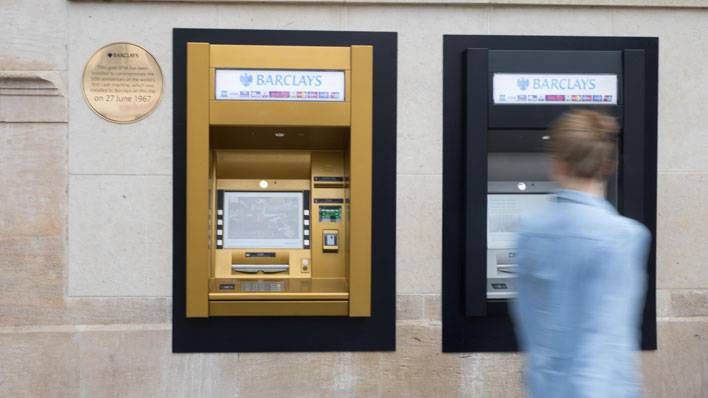
From the archives: The ATM is 50
From the moment the velvet curtain was drawn back at a Barclays branch in London’s Enfield, the way we bank was altered forever
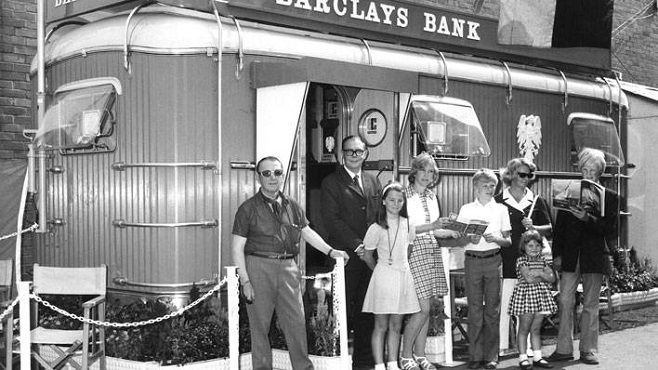
Barclays’ commitment to meeting customer needs has seen the bank conduct business in the unlikeliest of places. From livestock markets to cruise liners, we look back through the archives at eight of the bank’s most unusual branch locations.
1. The Docks
Back in a time when banking centred on the traditional industries of farming, fishing and shipping, Barclays maintained a physical presence at Britain’s major ports to serve the seafarers and fishmongers who traded in the docks. The bank opened its first port-based sub-branch at St Andrew’s Dock, in Kingston-Upon-Hull, in 1905. Branches were later opened at Tilbury, Southampton, South Shields, Grimsby, Salford Docks and Victoria Docks in London. Former Branch Manager Jim Jarvis, who joined the Tilbury Docks branch as a 16-year-old junior in 1955, remembers it as a “busy port, dealing with both cargo ships and cruise liners from P&O and Orient”. In the days before security companies, bank staff would move large sums of money to and from the local Post Office “in a Rolls Royce”.
Temporary premises at Lowestoft fish market, 1957
2. Cattle markets
Like the ports, livestock markets were busy places for trading and commerce. As this image of the sub-branch at the Market Drayton Cattle Market in Shropshire shows, such offices would typically occupy a small building within the boundary of the market site – often no more than a wooden hut. These branches were generally open only on market days or when there were special sales. The sub-branch pictured was opened in 1950. It closed during the foot-and-mouth outbreak of 1967 and never reopened.
Market Drayton Cattle Market sub-branch
3. Airports
Modern travellers may be used to seeing banks at major airport terminals, but Barclays was an early pioneer. In 1947 – at the dawn of the ‘jet age’ that would herald mass air-travel – the bank opened its first airport branch at London Airport (now known as Heathrow). This was supplemented by sub-branches at the Europa Terminal (now Terminal 2) in 1955 and the Oceanic Terminal (Terminal 3) in 1961. By the early 1960s, the bank offered 24-hour banking at Heathrow and later that same decade it was still the only bank with a full branch service at the airport. An article from the Barclays Bulletin in 1967 described some of the attractions for staff working at Heathrow: “…the chance of talking to celebrities; the glamour generally associated with flying and faraway places…and the hectic social life generated by a cosmopolitan airport community of some 40,000”. Meanwhile, Barclays opened branches at other airports, including Southend-On-Sea in 1956, Gatwick in 1958 and Luton in 1962, the latter at first only being “open occasionally by arrangement with the airport authorities…”
A 'Barclays Bulletin’ feature on the Heathrow branch
4. Drive-in banks
In the 1950s, the growing popularity of car ownership and the notion of the ‘drive-in movie’ inspired the idea of a drive-in bank. A race began between Barclays’ forerunner, Martins, and Westminster bank over which would be the first to embrace this innovative concept. Westminster won, but the Minister of Transport opened Martins’ first drive-in, the Charles Street branch in Leicester, on 2 March 1959. A second drive-in was opened at the Martins Epsom branch in 1966, its location being, as the staff magazine put it, “well outside the bingo belt but close to the gin and Jaguar belt”. The Leicester drive-in was taken over in the Barclays merger of 1969 and was still in business, along with several others, in 1985. Barclays sold the premises in 1993.
Drive-in branch at Charles Street, Leicester, 1959
5. Mobile banks
Barclays used mobile branches in a variety of locations at home and overseas. In the UK in the mid-1950s, Martins Bank – which merged with Barclays in 1968 – used mobile banks to visit agricultural and county shows and trade fairs and later to reach places that had no branches. The truck shown here was a mobile branch used at Kirkby in Merseyside. “The Liverpool areas of Kirkby and Croxteth had been built with very few amenities,” a former colleague recalled. “So nearly all the shops were mobile shops, there wasn’t a pub in the place, and we felt we should join the club. So we set up a mobile branch”. Barclays also used a similar domestic mobile branch in the 1960s, and in 1970s experimented with a new, more modern and secure Portakabin mobile bank, drawn by articulated lorry, which was used to visit industrial and commercial estates in the then new town of Milton Keynes.
Martins mobile branch at Kirkby
6. QE2 cruise liner
Spotting another opportunity to boost its international reputation, Barclays took on the banking operation aboard the QE2 cruise liner in January 1971. The ship had two branches: a main one for first class passengers and a sub-branch for everyone else. The bank proved popular, although colleagues reported how passengers would mistake them for concierge staff and ask about babysitting on board and other facilities. This unusual and prestigious location made it the subject of considerable media interest.
The QE2 counter, 1971
7. The hospital
A competition in Barclays News magazine in 1990 to find the UK’s smallest branch revealed some surprising bank locations. The sub-branch at St Mary’s Hospital in Newport on the Isle of Wight (now closed) was smaller than a snooker table and situated in a corridor. It opened only every Thursday between 11.30 and 14.30 for the convenience of hospital workers. For its two-strong banking staff, though, it was far from convenient: “From the moment they enter the room, set the security alarms and open the counter, they cannot leave,” Barclays News reported at the time. “Even for a call of nature.”
The cupboard-sized sub-branch at St Mary’s Hospital, Newport, Isle of Wight
8. Wimbledon
Perhaps the most iconic venue at which Barclays customers have banked is the All-England Club sub-branch – which was situated directly below Wimbledon’s Centre Court, and opened its doors only for the fortnight of the Championships.
It was established in the 1930s by Martins Bank (which merged with Barclays in 1969) and operated on the site for several decades, before a new branch was built in the gatehouse as part of major works in 1997 by the All England Club.
An article in ‘Barclays News’ from 1997 features deputy manager Angela Finbow – seconded from her usual role as assistant customer service manager at Wimbledon’s Broadway branch – describing a very busy, but thrilling, working environment within the original sub-branch.
She tells how celebrity sightings were frequent – with many competitors paying a visit to cash in their prize money. “The queues never went, from the minute we opened until the time we closed… it’s the extraordinary atmosphere which grabs you. As you walk in through the gate you’re in a different world… I loved hearing the crowd roar just above my head.”
The original All England Club sub-branch, under Wimbledon’s Centre Court, in 1970

From the moment the velvet curtain was drawn back at a Barclays branch in London’s Enfield, the way we bank was altered forever
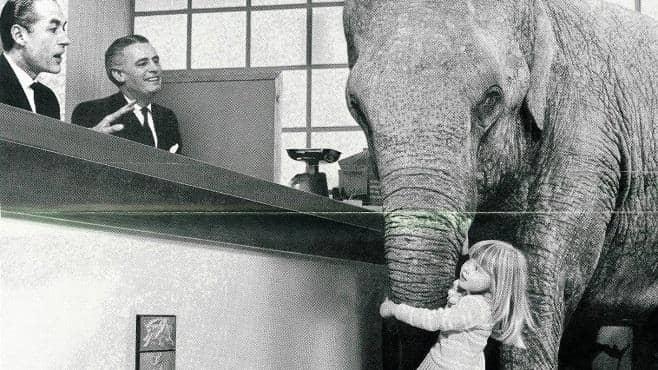
We take a nostalgic look through the Barclays archives at how the bank has promoted its children’s accounts through the decades
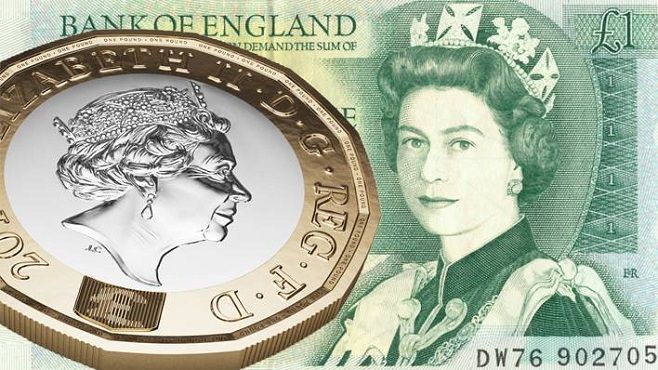
It was April 1983 and David Bowie was at number one in the charts with ‘Let’s Dance’ when the original £1 coin was introduced
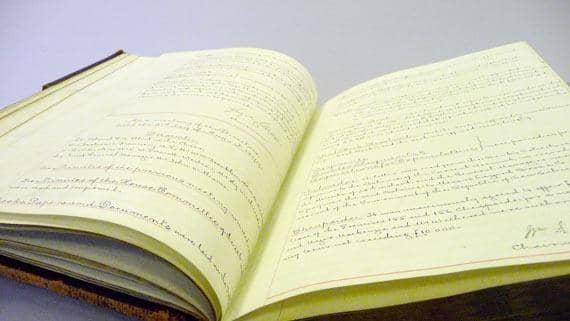
Barclays Group Archives are home to the records of Barclays PLC and its predecessors, dating from 1567 to the present day







